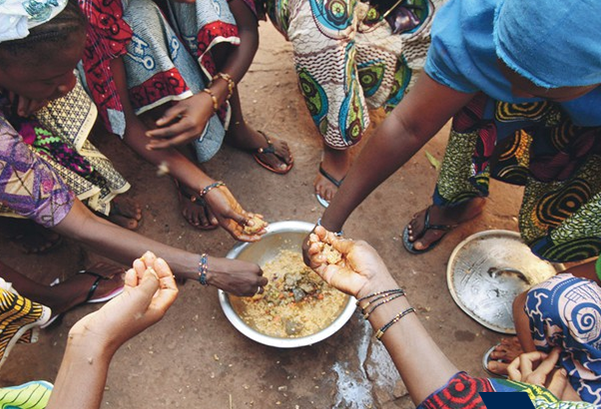Released Date
2022-06-12 | 22:06:00A global food security crisis is a threat to all countries

Food security refers to food availability and people's capacity to access it.
Due to food insecurity incentives, any region of the world may be affected by this phenomenon; However, because of geographical, ethnic, and political characteristics, the extent of this issue is much greater in some countries. According to the World Bank, food insecurity is a growing challenge in the Middle East and North Africa. In 2020, the MENA (the Middle East and North Africa) share of people in acute food insecurity globally was 20%, which was disproportionately high compared to its 6% share of the world's population.
Of course, the crises in Iraq, Syria, and Yemen have played a significant role. The situation is worse in conflicts such as Yemen and Syria. The United Nations estimates that the number of Yemenis suffering from food insecurity in 2021 has reached 24 million (83% of the population), of which 16.2 million need emergency food. The war in Syria has had devastating consequences; More than 12 million Syrians are in food insecurity, which has increased by 4.5 million in 2020. In Iraq, the increase in food insecurity has been caused by intermittent conflicts and fluctuations in global oil prices, so today, more than 4 million Iraqis require humanitarian assistance.
According to the Global Hunger Index, Afghanistan ranks ninth in severe food insecurity. Afghanistan is currently in a global food crisis, exacerbated by a Taliban offensive that will force millions to choose between emigration and starvation. Egypt's food crisis in 2008 and rising food prices have exacerbated internal unrest and conflict. The Mena region has experienced a state of disarray from 2010 to 2011, accompanied by regional drought.
Water scarcity, which has affected several countries, including Iran, Iraq, Yemen, and Algeria, in 2021 limits access to the resources needed for production. As the region becomes increasingly arid in traditional agricultural sectors, agricultural production is likely to decline in some countries, with Iran, Iraq, and the Persian Gulf countries at particular risk. The phenomenon could spread to other products and food sources. Imported food now accounts for half of all food in the Middle East and North Africa, and it increased by 90% in the GCC (Gulf Cooperation Council).
Russia's recent invasion of Ukraine has pushed up global food prices and put more pressure on the economies and populations of the Middle East and North Africa, which import net food and fuel, such as Morocco, Tunisia, and Egypt. Egypt is the largest importer of wheat globally, importing most of it from Ukraine and Russia. Thus, the Russia-Ukraine war is a serious threat to Egypt's food security and a threat to escalate malnutrition and reliance on foreign aid in Yemen. Water challenges exacerbated by climate change are likely to negatively impact population habitat and crop yields in the region, increasing food shortages and dependence on primary food imports and migration. Food insecurity and other factors such as climate change and conflict provide more significant incentives for migration to diversify household incomes, access to food, and withstand climate shocks. It can increase both rural to urban migration and international migration. In addition, due to high costs, lack of income opportunities, and unfavorable travel conditions, migration itself can cause food insecurity. A unique case of permanent international migration due to famine was the case after the Irish famine of 1845-1859. Famine played an essential role in stimulating mass immigration from Ireland.
In Iran, increasing production has not kept pace with the growing population and demand. Wheat is the country's main product, and bread made from wheat is the primary source of calories. From 1979 to 2016, wheat harvest more than doubled, but wheat consumption was more than production during this period. As a result, Iran depends on imports for vital food supplies. From 2011 to 2015, imports accounted for 23% of wheat, 52% of rice, and 71% of corn. According to the Food and Agriculture Organization of the United Nations, total imports accounted for 36.6% of Iran's grain needs in 2016, up from 18.1% in 2005. Iranian farmers typically consume two to three times more water per hectare of corn, rice, and wheat than the global average. As the water crisis escalates and global crises escalate, rising Iranian food prices could lose 70% of their agricultural land, while millions could be forced to migrate because of the Iranian plateau due to drying up rivers and declining groundwater. It is practically uninhabitable. According to the International Food Security Map, Iran is among the most dangerous countries, with Hormozgan, Kohgiluyeh and Boyer-Ahmad, Sistan and Baluchestan in the most insecure category, and the provinces of Khuzestan, Kerman, Ilam, and Bushehr in the category of insecure. Iran has experienced a recession in recent years due to long-term international sanctions. Rising food prices and declining subsidies have directly affected food security among the poor and vulnerable.
Fluctuations in agricultural production, rising food prices, natural disasters such as earthquakes, floods, droughts, and political instability in neighboring countries will harm people's food security. Also, the migration of people from strategic geographical border areas poses security threats. More basic measures are needed to ensure the country's food and water security. Restructuring guaranteed prices for specific crops in specific regions to reflect existing resources can promote new cropping patterns that are more suited to land and water conditions. Subsidy savings can, in turn, be used to support agricultural investment and innovation.
Moving crops away from waterlogged areas and improving irrigation efficiency can increase national yields while reducing water demand. Technology can also play an important role. In addition, Iran has significant potential for solar energy. Locally distributed solar desalination systems can also treat saline groundwater for reuse and recycling.
- No Source
User Comments
- There is no comment!